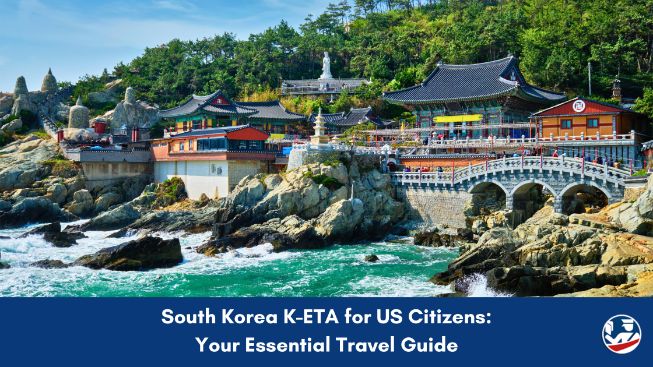
If you are planning a trip to South Korea, the Korea Electronic Travel Authorization (K-ETA) is the required pre-screening for most visa-exempt visitors. While U.S. citizens are currently enjoying a temporary exemption from this requirement, understanding the K-ETA is crucial for seamless travel, especially if you plan to visit South Korea in 2026 or want to expedite your arrival.
The K-ETA is not a visa, but a mandatory authorization designed to strengthen border security and streamline entry for short stays. This guide provides the facts you need to know about K-ETA, its current status, its future mandatory date, and the steps you need to take to obtain a K-ETA quickly and accurately.
Apply for your South Korea K-ETA quickly and securely with iVisa today! Let iVisa help ensure your application meets all photo and data requirements so you can focus on your trip.
On This Page
- What is the South Korea K-ETA?
- Do I Need a K-ETA Right Now?
- K-ETA vs. Visa: The Difference
- Applying for Your K-ETA: DIY vs. Full-Service
- The Official South Korea K-ETA Process: A 3-Step Guide
- Beyond the K-ETA: Other South Korea Entry Requirements
- South Korea K-ETA Frequently Asked Questions (FAQ)
What is the South Korea K-ETA?
The K-ETA is an online electronic travel authorization that permits eligible visa-free travelers to board a flight or ship bound for the Republic of Korea. It is not a visa. It is a pre-screening system for:
- Tourism or sightseeing.
- Visiting family or relatives.
- Short-term business meetings (excluding profit-making activities).
- Participating in events or non-commercial meetings.
Do I Need a K-ETA Right Now?
No, as of this date and until December 31, 2025, U.S. citizens are currently exempt from the K-ETA requirement.
- Exemption Period: The K-ETA requirement is temporarily suspended for U.S. citizens until December 31, 2025.
- Future Requirement: Starting January 1, 2026, the K-ETA will once again become mandatory for U.S. citizens traveling for short, visa-free purposes.
Note: You can still choose to apply for a K-ETA voluntarily during the exemption period to receive benefits upon arrival (see below). Travelers aged 17 and under, and 65 and above, are typically exempt from the K-ETA requirement.
K-ETA vs. Visa: The Difference
| Document | Purpose | Mandatory Status |
|---|---|---|
| K-ETA | Authorization to Travel (Short-term tourism, business meetings, events). | EXEMPT until Dec 31, 2025; MANDATORY thereafter. |
| Visa | Entry Permission (Employment, long-term stay, teaching, or other non-short-term purposes). | Required for activities outside K-ETA scope |
Applying for Your K-ETA: DIY vs. Full-Service
If you choose to apply voluntarily now, or when the K-ETA becomes mandatory, you have two options. Beware of unofficial sites that charge significantly inflated fees.
- Applying On Your Own (DIY): For travelers comfortable navigating the official government website or mobile app, applying directly is the most cost-effective method (paying only the official fee).
- The Full-Service Route (Simple and Secure): For travelers who prefer a simplified interface and expert review, a dedicated service is a great option. iVisa simplifies the process, helps ensure your data and photo meet the strict K-ETA specifications, and provides 24/7 multilingual support.
The Official South Korea K-ETA Process: A 3-Step Guide
The K-ETA application must be completed online through the official portal or mobile app.
| Requirement | Details |
|---|---|
| Official Gov. Fee: | 10,000 KRW (approx. $7-$9 USD), plus bank processing fees. |
| Validity: | 3 years from the date of approval (Multiple Entry). |
| Duration of Stay (U.S. Citizens): | Up to 90 days per visit. |
| Application Timing: | Recommended at least 72 hours in advance. The official site advises 2 months before departure. |
Step 1: Get Your Information Ready
- Your valid U.S. passport.
- A recent color photo of your face (JPEG format).
- Accommodation details (e.g., hotel name/address).
- A credit or debit card for the non-refundable fee.
Step 2: Complete the Online Application
- Access the official K-ETA website or mobile app, or use an accredited service like iVisa.
- Select the K-ETA application option.
- Fill in personal and travel information.
- Upload your photo and passport information page.
Step 3: Pay and Receive Your Authorization
- Pay the non-refundable 10,000 KRW government fee.
- Submit your application.
- Processing Time: While the system typically provides a result in 24-72 hours, officials recommend applying well in advance (up to 2 months) to account for high volume or manual review.
- Confirmation: Once approved, you will receive your K-ETA approval via email. The K-ETA is electronically linked to your passport. It is advisable to have a printed paper copy to present to the immigration officer upon arrival.
Beyond the K-ETA: Other South Korea Entry Requirements
The K-ETA simplifies entry, but final admission remains at the discretion of the Korea Immigration Service. An approved K-ETA does not guarantee admission to the Republic of Korea.
Be prepared to show:
- Valid Passport: Your passport must be valid for the duration of your stay in Korea (though 6 months' validity is always recommended for international travel).
- Proof of Onward Travel: A confirmed return or onward ticket is required.
Key Benefits of Applying Voluntarily (While Exempt)
If you have an approved K-ETA, you are exempt from having to fill out and submit the paper arrival card upon entry to South Korea. This means:
- You can skip the paper arrival card form,
- You move through immigration faster, and
- The process is more convenient and contactless.
South Korea K-ETA Frequently Asked Questions (FAQ)
If you apply now, you gain convenience at the airport (exempt from the arrival card) and secure a 3-year validity at the current fee, protecting you against potential fee increases when the K-ETA becomes mandatory again on January 1, 2026.
As a U.S. citizen, the K-ETA allows you to stay for up to 90 days per visit. You can enter multiple times as long as your K-ETA is valid.
No. Once the application is submitted and the fee is paid, the information cannot be modified. If your passport information or personal details change, you must submit a new application and pay the fee again. For this reason, many travelers choose to apply through a trusted service like iVisa to avoid potential mistakes that could cause delays or denials.
Travelers aged 17 and under, and 65 and above, are typically exempt from the K-ETA requirement. However, if they apply to receive the arrival card exemption benefit, the fee will be charged.
Apply for your South Korea K-ETA quickly and securely with iVisa today! Let iVisa help ensure your application meets all photo and data requirements so you can focus on your trip.


